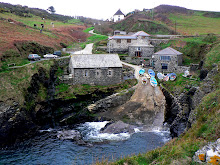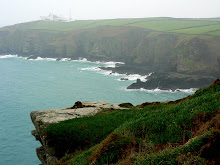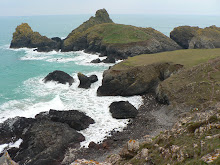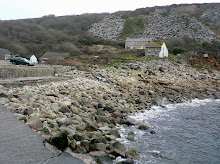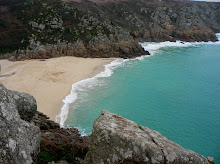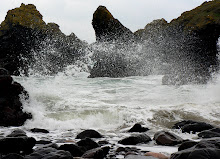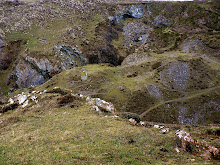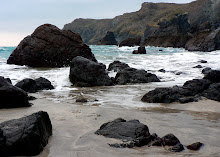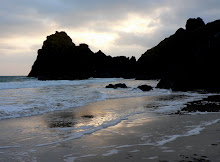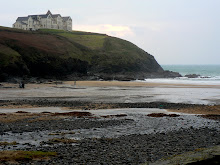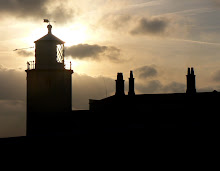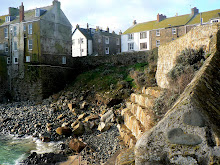When we first considered taking a holiday in Snowdonia we were both drawn to the idea of being based in a remote area surrounded by mountains. This was probably driven by a natural instinct to avoid the main tourist areas. On the other hand we didn't want to be so far off the beaten track that our explorations would be restricted or reduced, in terms of travel time and ease of access. What we found surpassed all expectations, and involved no compromises! Our idyllic cottage was called Ty Maen ('My House'), a converted stone barn nestled in the tiny village of Nant Peris in the heart of Snowdonia, with Snowdon rising steeply to the right side, and The Carneddau mountain range to the left.
For added interest (as if any were needed!) our neighbours up the lane regularly passed by our cottage, often pressing their noses against the window to see what we were doing. I often wonder how Frank is doing. Frank wasn't what you'd call a looker. He had an untidy, shabby appearance and wore a coat that had seen better days. That's why we called him Frank, short for Frankenstein - friendly sort of sheep though!
Our first mountain trek was described in the book as 'A Taming Walk in the Devil's Kitchen.' As it was just a 10 minute drive away around the base of a mountain close to Ty Maen, our cottage, it seemed an ideal walk. Actually we could have accessed it without getting in the car at all! Had we climbed up to the summit of Glyder Fach (994m), crossed over the top, and looked down the other side we would have seen Cwm and Llyn (mountain and lake) Idwal laid out before us. We did attempt this climb later in the week, but that's another story ... .
Idwal is said to be the 'haunt of demons, inspiring murderous thoughts, environed with horrible precipices,' and indeed in the 12th century Idwal, son of Owain Gwynedd was brutally murdered by Dunawd, in whose care he had been entrusted. We didn't see any devils or demons, or have any murderous thoughts (that I remember), mind you, when huge dark menacing clouds rolled over the mountains and a heavy mist hung over the valley, the place did take on a more sinister appearance ... and come to think of it, it was 'environed with precarious precipices' but the ones we saw had extreme sport fanatics dangling from them!
I preferred the alternative description of Cwm Idwal, 'the most perfect hanging valley in Snowdonia, a fine place to study geology and nature and to see many rare species of Arctic plants; a legacy of glaciation from the last ice age'. It was also a peaceful, stunning, remote and unspoilt place in which to take our first walk of the holiday.
The route started with a gentle walk past rocky glacial deposits to Llyn Idwal, a picturesque lake filling the basin of this perfect u-shaped valley, overlooked by a 360 degree panorama of mountain peaks. Following the path down the left side of the lake we continued forwards and upwards past the rock climbing grounds of the Idwal Slabs, stopping to watch in awe, even disbelief, at climbers laden down with all manner of equipment needed to get them up the sheer rock face and down again in one piece, and to give them the adrenaline and achievement rush they were seeking. We pursued our flatter, gentler but still challenging route past them, climbing up and around Cwm Idwal, where we were rewarded with remarkable views over the valley. Our return route was diverted downwards when we hit an obstacle that I didn't wish to overcome - the trail had been commandeered by a deep crevice cut out of the mountain side by a steep and impatient waterfall. It would have been a step too far, too deep, too steep and too wet for me, so we descended via a gentle slope back to the lake, stopping for more photos of this very pretty valley.
The following day we decided to tour around the Isle of Anglesey, clockwise. Our first stop of the day was on the south coast, and it was very nearly our last stop! After driving along the winding road through Newborough Warren and Forest we eventually reached the car park, just behind the beach on Llanddwyn Bay. The beach was beautiful. Wide, sweeping, with pale sands, fringed by the forest and grassy dunes and with misty views of Snowdonia on the horizon. We could see Llanddwyn Island ahead of us in the distance, jutting out from the beach into the sea, and knew it was possible to walk across to it, so that was our aim. However, distance can be deceptive in such landscapes and though we knew it would take a while to reach it, we had a feeling it would be worth the time and effort. We were right.
Llanddwyn Island is a magical place, with rolling dunes, large rocky outcrops, mudflats, saltmarshes and a handful of historic buildings
on it, Snowdonia views
beyond it and a romantic legend
behind it. If that were not enough it is also part of the Newborough Warren National Nature Reserve, with a wide range of plants, nesting seabirds, and the unusual breed of Soay Sheep. It's not quite an island, and remains attached to the mainland at all but the highest tides.
As you approach the 'island' there are several large rocks in the sand. These are pillow lavas, part of the Precambrian Gwna Group, formed by undersea volcanic eruptions; as the hot molten rock met the cold sea-water a balloon-like skin was formed which then filled with more lava, forming the characteristic pillow shape. These rocks extend down much of the length of the island, giving it it's interesting rolling topography.
The name Llanddwyn means 'The Church of St Dwynwen'. She is the Welsh patron saint of lovers, making her the Welsh equivalent of St Valentine. She lived during the 5th century, fell in love with a a young man named Maelon but rejected his advances. This, depending on which story you read, was either because she wished to remain chaste, or because her father wished her to marry another. She prayed to be released from the unhappy love and dreamed that she was given a potion to do this, however the potion turned Maelon to ice. She then prayed that she be granted 3 wishes, 1. that Maelon be revived, 2. that all true lovers find happiness and 3. that she should never again wish to be married. She then retreated to the solitude of Llanddwyn Island to follow the life of a hermit. Pilgrimages and offerings were made to her holy well and shrine on the island such that it became the richest place in the area during Tudor times. This funded a substantial chapel that was built in the 16th century on the site of Dwynwen's original chapel. The ruins of this can still be seen today.
When we eventually tore ourselves away from this idyllic spot, it seemed that we had to rush the rest of the Anglesey coastline to fit everything in, but the truth was that nothing matched up to what we'd seen and experienced at Llanddwyn! That said, we continued clockwise round the coastline, stopping briefly to reflect on a little town called Aberfraw, as it had been advertised as a place worth seeing. No reflection on the good folk of Aberfraw, but reflections was all there was to see - pretty coloured cottages lined up on the river bank being reflected in the water!
Heading up the coast we crossed over to Holy Island to visit Holyhead, major ferry port, and essential link to Ireland. After a colourful walk through the marina, and a tasty snack in the cafe overlooking the beach front we set off to South Stack for a bracing walk along the coast path to check out the famous Lighthouse on South Stack Island. The lighthouse has warned passing ships of the treacherous rocks below since its completion in 1809. The 91ft lighthouse is visible to passing vessels for 28 miles, and was designed to allow safe passage for ships on the treacherous Dublin-Holyhead-Liverpool sea route. It provides the first beacon along the northern coast of Anglesey for east-bound ships. But until 1828 when an iron suspension bridge was built, the only means of crossing the deep water channel on to the island was in a basket which was suspended on a hemp cable. The suspension bridge was replaced in 1964, but by 1983 the bridge had to be closed to the public, due to safety reasons. A new aluminium bridge was built and the lighthouse was reopened for public visits in 1997. Thousands of people flock to the lighthouse every year.
There are over 400 stone steps down to the footbridge, and the descent and ascent provide an opportunity to see some of the 4,000 nesting birds that line the cliffs during the breeding season. The cliffs are part of the RSPB South Stack Cliffs bird reserve, based at Ellin's Tower above, on the Anglesey Coastal Path. From this vantage point we enjoyed superb views of this rocky coastline, and the rocky island of South Stack.
By the time we reached the peaceful little village of Moelfre on the north of the island, the sun was low in the sky, and energy levels low in our systems. After taking our fill at the local hostelry we took a brief walk along the Anglesey Coastal Path to see what Moelfre had to offer. It was apparent that Moelfre has a lot to be proud of, and is well known in many parts of the world as the home of one of the finest and renowned lifeboat stations in the world. The bravery of the men that have manned the boats over the years has been exceptional, with many bravery medals being won by a multitude of lifeboat men. A fine bronze statue of Dic Evans, Moelfre's hero and one of the most decorated RNLI Lifeboat Coxswains, stands 7 foot proud as testimony to Moelfre's history of heroism. Dic Evans received his first medal in 1950 when called out to the Hindlea of Cardiff when it was in distress in a hurricane force wind gusting to 104 miles per hour. Thanks to his bravery all the crew were rescued.
Our short walk and exploration of this 'little town with a big claim to fame' came to an end as we approached the photogenic picture postcard row of whitewashed stone cottages overlooking the tiny porpoise-shaped island of Moelfre just off shore, home to many sea-birds and apparently also to the occasional porpoise passer-by! But with the light fading fast it was time to head off back towards the Menai Bridge and Mainland, with the briefest of stops at Beaumaris for a glimpse of the Castle.
Beaumaris Castle, begun in 1295, was the last and largest to be built by King Edward I in Wales. Raised on an entirely new site, without earlier buildings to fetter its designer's creative genius, it is possibly the most sophisticated example of medieval military architecture in Britain. It is undoubtedly the ultimate "concentric" castle, built with an almost geometric symmetry. Conceived as an integral whole, a high inner ring of defences is surrounded by a lower outer circuit of walls, combining an almost unprecedented level of strength and firepower. Before the age of cannon, the attacker would surely have been faced with an impregnable fortress. Yet, ironically, the work of construction was never fully completed, and the castle saw little action apart from the Civil War in the 17th century.
Just a few miles further round our 'clockwise tour' of Anglesey we were back at the Menai
Bridge, where we were treated to a stunning display by the sun casting it's golden glow over the Menai Straits before it disappeared out of sight, and we disappeared out of Anglesey.
The following day we decided to stay local and see what Llanberis had to offer. The town is a riot of colour, with every building in the High Street painted a different colour of the rainbow! A pretty little town with a lot of attractions to offer visitors. Thankfully we saw it at it's best - off peak, uncrowded and on form! Running alongside the town, are the even prettier twin lakes of Llyn Padarn and Llyn Peris. These cut through the mountain range creating the Llanberis Pass, in an area noted for its rugged beauty, and which just happens to be where Nant Peris, and Ty Maen are located.
The Llanberis lake railway runs along the northerly shore of Llyn Padarn with the main station located in the Padarn Country Park, across the valley from the town amidst unspoilt woodland and a range of tourist attractions related to the slate industry. The tiny locomotives used on the line have all seen service in Dinorwic Quarries at one time or another where they once hauled slate wagons in the quarry. Commercial Quarrying in the Elidir mountain began at Dinorwic in the late 19th century, but the quarry closed in 1969 and was converted into the National Slate museum, courtesy of the Heritage Lottery Fund. Both the railway and the museum sounded like a fun and different way of seeing and understanding the local area, so we were soon 'all aboard' and chuffing and chugging our way around the lake!
The train ride was a great success, providing panoramic views over the lake, and even a stop along the way to capture them on camera. We conveniently alighted from the train at the entrance to the National Slate Museum. Only it was not so much a museum as a pocket of history, looking for all the world as if the quarrymen and engineers had only just put down their tools and left the courtyard for home! As well as bringing the history of slate mining alive, it was also a minefield of photo-opportunities, and one which I embraced with more enthusiasm than I thought possible over stacks of slate and rusting machinery! A happy couple of hours was spent poring over the angles, shapes, combinations, colours and textures of what is still a thriving industry for Llanberis.
To round off our socio-economic history of Llanberis we paid a visit to the 'Electric Mountain,' home to the greatest
modern industrial wonder of Wales and, some would say, the world. Electric Mountain houses a massive hydroelectric power station. Built deep inside, amidst miles of tunnels carrying roads and water, is a turbine and generator chamber said to be the largest underground chamber ever excavated by man. This had to be worth a visit.
The bus tour of the power station started from the 'Dragon in the Mountain' exhibition in Llanberis, where we duly offloaded rucksacks and cameras (important for National security) into prescribed lockers (much more important, for Camera security!) before joining the tourist trail for the 5 minute journey to the mountain, and the 30 minute journey through and down into the mountain! It was like a scene from a James Bond Movie, bizarre in the extreme. Travelling down a steep incline, along wide roads, by bus, in a mountain, wearing a safety hat! We were allowed off the bus and escorted on a mini tour of a small section of the power station. However, there wasn't anything mini or small about what we saw! I wouldn't (and couldn't) attempt to describe the inner workings of this impressive place, suffice to say everything within it was on a gigantuous scale, from the height and size of the working areas to the plant and machinery. Once we'd surfaced out of the mountain I felt less like Alice in Wonderland and things returned to their normal scale. Back at the exhibition centre things lost their perspective once more ... .
On reaching the locker room I looked in disbelief and horror at my locker door, which was open, and empty! My camera, hundreds of holiday photos, and the mainstay of my holiday was gone. The manager was called, the saga told and the police nearly alerted ... until it was discovered that the key to my locker had the incorrect number on it, so the empty locker wasn't mine ... it was the one above mine, same position, wrong row. After profuse apologies from the manager, a cup of tea, and relieved expressions all round, I left the building tightly clutching my camera, and once again looking forward to the rest of our holiday!
We woke the next day to bright sunshine on the surrounding mountains, a nosey sheep at our window and a great spotted woodpecker in our garden at Ty Maen! It was going to be a great day! Perfect weather for climbing a mountain or two. But not before we'd re-traced our steps to Dolbadarn Castle, to re-take the photos taken earlier in the week, to re-place the previously grey background with a bright blue one!
Dolbadarn Castle stands rather forlornly on it's rocky hillock some 80 feet above Llyn Padarn. It's strategic value is perhaps best recognised by reference to a map. Clearly, it's position at the tip of the lake allowed the garrison to blockade anyones movement through that part of the north, then as now a main link to the rest of Wales. The military worth of the spot was evidently recognised as early as the 6th century but surviving masonry dates no earlier than the 1200's. An impressive structure, both imposing and good at posing!
Glyder Fach (994m) was even more impressive, but also more challenging. The ascent began just a stone's throw away, at the end of the lane leading to Ty Maen. It started well, but very soon the footpath lost it's definition and disappeared altogether, making it difficult to trace the way forward. But at every step there was always a guaranteed jaw dropping view to compensate; views behind of Ty Maen getting ever smaller as it blended into the mountain side; views of the Snowdon Mountain Railway chugging it's way across the sharp ridge between mountain and sky, and views right down the Llanberis Pass, guarded by mountains, filled with lakes and leading to places unknown in the distance.
As the gradient increased, so too did the amount of times we stopped to gaze in awe at it! And the higher we climbed, so the mountain tantilisingly revealed a little more of it's secret picture. As the route got steeper the craggy scree gave way to huge rocky boulders, and the ascent grew more challenging. But our determination to get to the top also increased, encouraged all the way by the magnificent photo opportunities we were offered. As we climbed even higher the terrain changed again, to a broad grassy plateau stretching all the way to the summit, which was always just out of sight! We kept going for some considerable time, but on reaching the conclusion that we were probably still an hour off reaching the summit, we had to make the decision to start the descent. After all, we had a train to catch!
Our second mountain climb of the day was up the highest mountain in Wales (1085m) but it wasn't going to be as strenuous as the first. We'd planned to take the Snowdon Mountain Railway up to the (temporary) summit, and having had to pre-book our ticket we really didn't want to miss the train. I'd climbed the more strenuous route up Pyg track some 7 years previously, so this wasn't going to be a guilt trip! But it did seem we were destined not to reach summits that day. The new £8.3 million Visitor Centre being built at the top of Mount Snowdon was still under construction and would continue to be for another 2 years. All the building materials were being transported to the summit by the 8 trains in service, which meant a reduction in scheduled trips, as well as the route, by 50%. We knew in advance that our journey would be foreshortened, but the views even from part way up, were going to be well worth the compromise.
As our train left Llanberis station we began the steep incline up the first of the two amazing viaducts crossing Afon Hwch, passing a beautiful waterfall and ancient forest. Beyond the waterfall the train emerged into open, treeless countryside and we had our first glimpse of the sharp craggy peak of Snowdon. A quarter of the way up we crossed the passing loop at Hebron, site of a small ruined Chapel which held its last service in the 1950’s. Just as we approached the halfway point the train passed through a cutting that was hewn out by hand and blasted with dynamite in the winter of 1894. At the halfway point the train moved into the second loop in the track to take on water before continuing it's way up to Rocky Valley. This area is the termination point when high winds prevent the trains from reaching the Summit, neither of which was relevant to our trip!
Beyond the halfway mark the black volcanic rock face of Clogwyn du’r Arddu came into sight, closely followed by the Station at Clogwyn, the termination point prior to the Summit opening. This was our prompt to get out of the train and check out the spectacular views - up through Pen-y-Pass, up the face of Glyder Fach which we'd climbed that morning, down the mountain below us to Ty Maen, our tiny cottage, along the Llanberis pass, across the slate mountains, over the twin lakes and way, way beyond.
The next day was a mountain-free zone! We chose instead to drive to the unique and quirky town of Portmeirion, located on it's own private peninsula, perched on a tree-cladded hillside overlooking Whitesands Bay. Portmeirion is a private resort which was built by Sir Clough Williams-Ellis between 1925-1976. The architecture is primarily known as Italianate, with some buildings designed by the architect and others being rescued follies from other locations.
Portmeirion's colorful and flamboyant architecture and landscape offered a wealth of photo opportunities, and had it been empty of tourists, the photos taken would have been that much better! Having said that, it was a fascinating place and we enjoyed exploring all the nooks, crannies, follies and fantasies created by the architect. We also enjoyed a picnic with uninterrupted and unpopulated views over the breathtakingly beautiful wide sweeping sands of Whitesands Bay.
We continued our drive, hugging the west coastline of Wales along the north shores of Cardigan Bay, and past the imposing and spectacularly sited Harlech Castle, which seems to grow naturally from the rock on which it is perched! But our destination was Barmouth, a small but popular Victorian seaside town
, closely backed by steep and jagged rocky crags, fronted by ash-blonde sands and bordered by the dramatic Mawddach estuary. Whilst (in our opinion) there were too many people around to make this a photogenic landscape, there was no denying that the quaint old town of Barmouth has been blessed with a dramatic, almost theatrical backdrop to it's pretty streets and beach-scape.
The imposing white 'Bath House Cafe' is also impressive, being stunningly situated on a stretch of clean pale sand, facing mauve mountains in the distance to one side, the blue of the ocean on the other and a pretty estuary with colorful boats and bridge in between. Oh, and it also got the thumbs up for having great cappuchino and superb subject matter on it's menu!
As if to round the day off perfectly we drove back along the coast, along the south Lleyn Peninsula, and found Porth Neigwl. We'd been looking on the map for a quiet stretch of coastline which would provide us with a natural landscape, an interesting beach, a pretty landscape, a peaceful walk, and, just maybe, a perfect sunset. The remote beach at Porth Neigwl ticked all the boxes. We walked for a couple of hours on a deserted stretch of sand, sprinkled with stones and shells, edged by dunes and framed at the far end with mountains. There was no adjoining town, no buildings, no people, no noise, just nature - and the most amazing coral pink sunset casting it's reflection on the sea, before disappearing behind the mountain. What a special place.
During our holiday in North Wales we'd been around valleys, across islands, up mountains, inside mountains, along beaches, in trains and through towns. What we hadn't done was a walk in the Welsh countryside, so that's what we decided on for our last day.
Our first walk was called 'An Alpine Journey Above the Llugwy', and it encircled Capel Curig. At the heart of the Snowdonia National Park, this rugged mountain village is the mecca for climbing and walking in Snowdonia. Ringed by Moel Siabod, The Glyders and Carnedds (mountains), Capel Curig stands before the majestic view of the Snowdon Horseshoe. The Afon Llugwy (river tributary) flows through the village with beautiful falls at Pont Cyfyng, and the twin lakes Llynnau Mymbyr fill the valley, close to Plas y Brenin (The National Centre for Mountain Activities). Quite impressive for such a little village! And there's more. In the 1950's the Pen y Gwryd Inn became a centre for planning Alpine and Himalayan expeditions. Here Lord Hunt and his team, who in 1953 were the first to climb Everest, met to make the final preparations before departing for Nepal. The Climbers' Bar has a wood ceiling that has been autographed by many world famous climbers, including the summit pair, Sir Edmund Hillary and Tenzing Norgay.
Our short walk might not have been on the same scale as Everest, but in 4 miles it rounded the valley, taking in spectacular views of the wide sweep of mountains that surround the village and the Llugwy Valley. We climbed up hills, over crags, down dales, across pastures and through bogs (that was me!); jumped streams, crossed rivers, skirted woods and walked along the shores of the lake, before returning to the start point, the cafe, Joe Brown's climbing gear shop and our car, all of which we were glad to see for very different reasons!
Imagine a lovely unspoilt village in the heart of the Welsh countryside, it's picturesque bridge crossing the River Colwyn just upstream of it's confluence with the River Glaslyn. Charming stone and slate cottages line narrow winding roads through the village, and mountains surround it on all sides. This is Beddgelert, site of our second walk on our last day in North Wales.
Our walk closely hugged the twists and turns of the River Glaslyn as it tumbled over rocks, rushed around boulders and cascaded down the uneven bed of the Aberlaslyn Pass. That made it all the prettier. However the footpath was just as varied as the river-path, and that made it all the trickier! At one point the path consisted of a narrow ledge, 3 feet above the river, about 12 inches wide, but with 6 of those under the overhang of the rock above. But as the path got trickier the riverscape got prettier, the tree lined banks got thicker and so we continued along the route, keen to see what lay ahead. It was another tricky bit! This time a leap was required, across some wet boulders and onto a wooden path leading us upwards and out of trouble. I say 'we' but you'll understand I mean 'me', as I appear to be the one without any sense of balance, but with an all too vivid sense of fear. But without wishing to dwell on the negatives, this was indeed a very pretty riverside walk, as I hope the photos confirm.
But just as our walk wasn't complete without visiting Beddgelert's namesake, neither can we leave this posting without mentioning the tale of Llewelyn and his legendary hound, Gelert. The story, as written on the tombstone reads:
"In the 13th century Llewelyn, prince of North Wales, had a palace at Beddgelert. One day he went hunting without Gelert, "The Faithful Hound", who was unaccountably absent. On Llewelyn's return the truant, stained and smeared with blood, joyfully sprang to meet his master. The prince alarmed hastened to find his son, and saw the infant's cot empty, the bedclothes and floor covered with blood. The frantic father plunged his sword into the hound's side, thinking it had killed his heir. The dog's dying yell was answered by a child's cry. Llewelyn searched and discovered his boy unharmed, but near by lay the body of a mighty wolf which Gelert had slain. The prince filled with remorse is said never to have smiled again. He buried Gelert here". It is now widely accepted that the village of Beddgelert has taken its name from an early saint named Kilart or Celert, rather than from the dog. The existence of the "grave" mound is ascribed to the activities of a late eighteenth-century landlord of the Goat Hotel in Beddgelert, David Pritchard, who connected the legend to the village in order to encourage tourism and to boost his own takings.
Whether you believe in the authenticity of the legend or not, the fact that Beddgelert translates into 'Gelert's Grave' is enough to keep the myth and the tourist coffers alive and healthy, and anyway a salutary but cautionary tale with a moral is always a good one to tell at parties!
I might even spread a rumour myself - about North Wales having more than it's fair share of beautiful scenery in the UK. The moral to this story is check it out for yourself, you'll be pleased you did!


